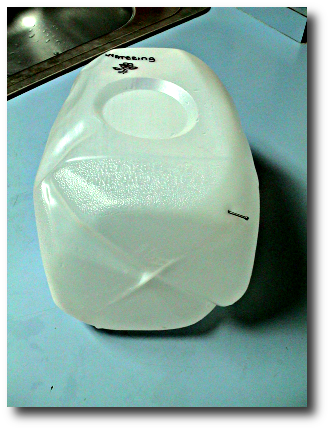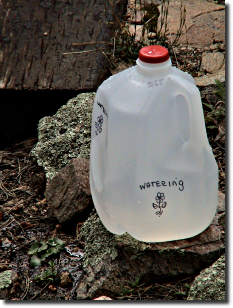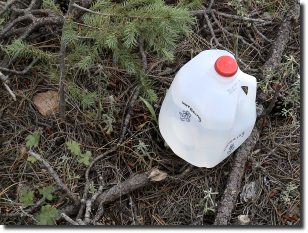

My husband and I have planted trees in our forest many times. I found, through experience, that giving the newly planted trees water at least once a week helped increase the survival rate. But, we often planted the trees some distance from our house where a hose would not reach and in areas with very steep slopes. Watering a plant on a steep slope must be done slowly, giving the water time to sink into the ground, or the water merely runs past the plant and downhill.
After trying several methods to water the newly planted trees, I finally settled on the method I describe in this tip: I used my collection of empty milk jugs. Milk jugs with a screw-on top work best. I put a small hole in the bottom corner of each jug, opposite the handle. In the image above, I used a small brad; often, so the water came out slower on a very steep hillside, I would use a sewing straight pin, making one or two very small holes.
The larger the hole you make, the more difficult the jug is to fill and the faster, of course, the water runs out. The smaller the hole, the less water will leak out as you carry the jugs to the plants that need watering (make sure the cap is screwed as tight as possible when you are transporting the jugs) and the more water will seep in for the plant. But, of course, a milk jug with a very small hole will take longer to empty than one with a larger hole.

Here is the jug, perched on a rock, above a small alum root plant in my small rock garden. This garden is very difficult to water with a hose or watering can as it is very steep.
When I transplant new plants into this garden, I set up milk jugs up the hill from the plants, balancing each on a rock, to give them a good watering. I move the jugs around as each plant gets enough water.
After some water has leaked out of a jug, a vacuum forms in the top of the jug, depending on how well the cap screws on. You can use this phenomenon to control the flow of water from the jug. If the cap is screwed on very tight, the flow will slow to a mere trickle. An open jug top lets the water flow out freely.

Here I'm watering a small fir tree on a very, very steep slope. I often use branches or small rocks to balance a jug. The jug should be up hill, about 6 to 8 inches from the tree to be watered. This way, the ground gets wet above the tree; water will continue to flow downhill underground to the roots. If you put the jug right next to a tree, the water will not have time to flow down to the tree root.
Water is fairly heavy; a gallon of water weights 8.3 pounds. I use my garden cart to transport about 12 milk jugs of water as close to the trees as possible. But, then I usually have to carry a jug in each hand up to where the trees are planted. The trees are never, of course, downhill from where I can get my garden cart into.
You may have noticed that I marked the jug quite clearly as one of my watering jugs. One time my husband needed some empty milk jugs to store dirty oil from an oil change in one of our vehicles. He grabbed a couple of my watering jugs and was not too pleased when the oil began leaking out. Hence, the distinct and easily seen markings.